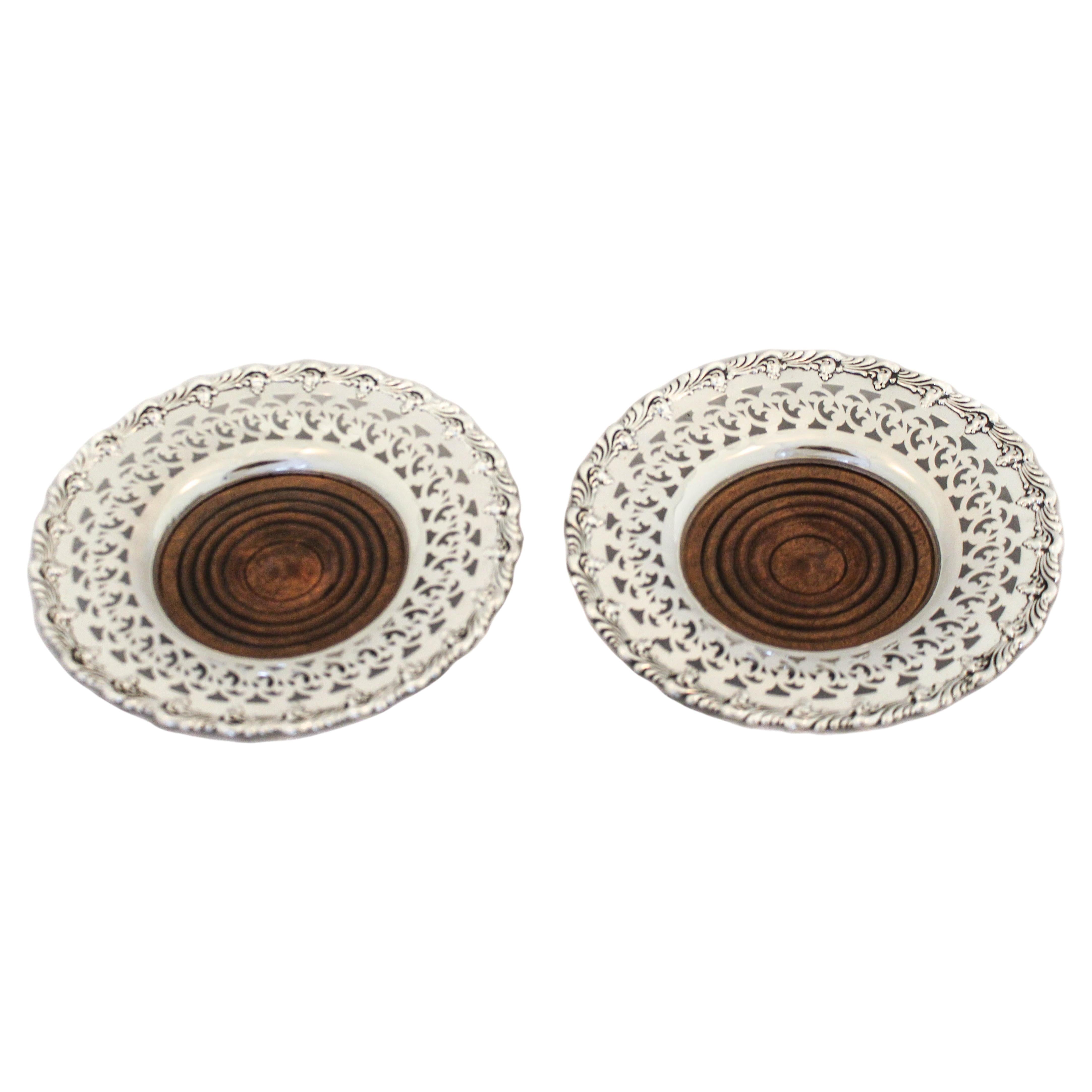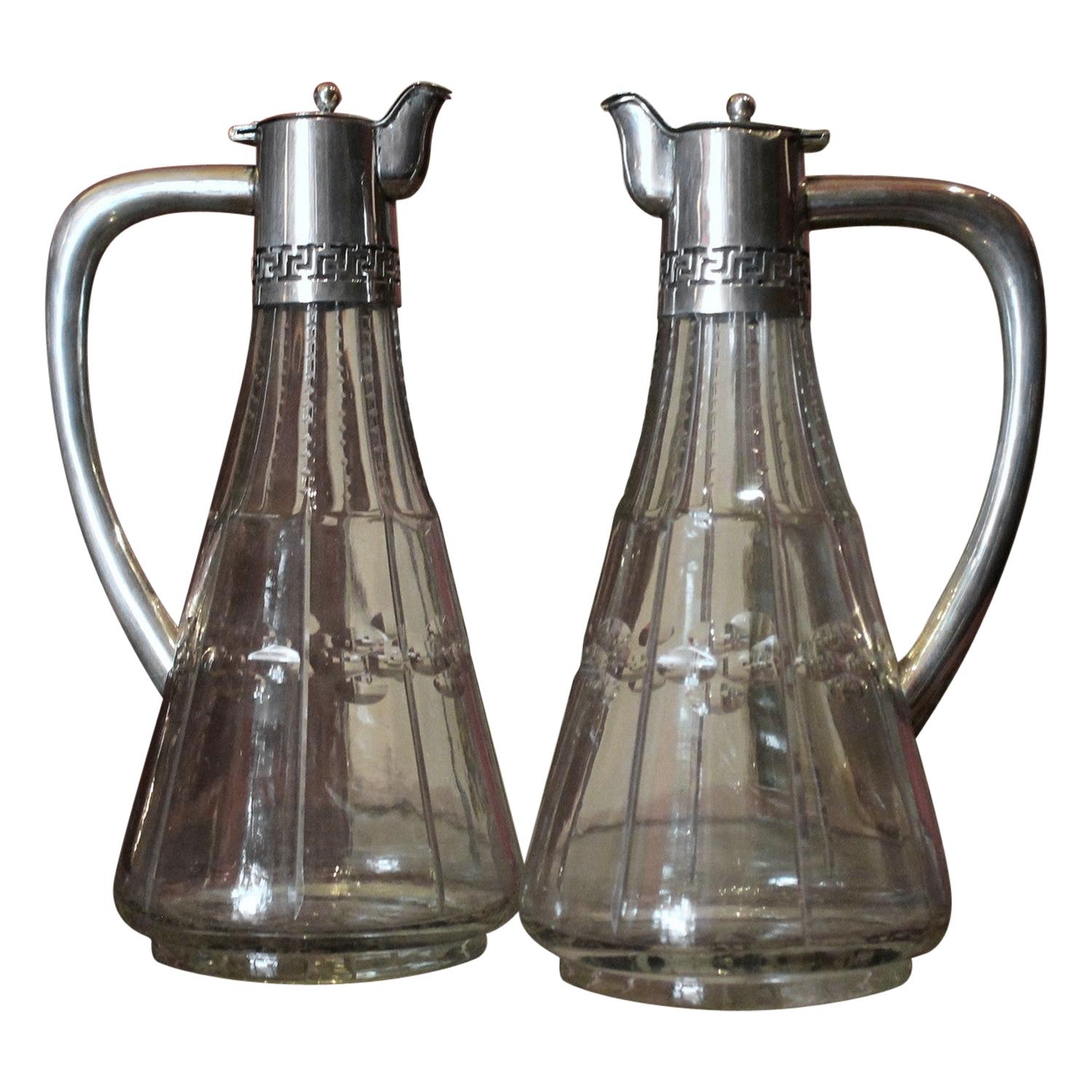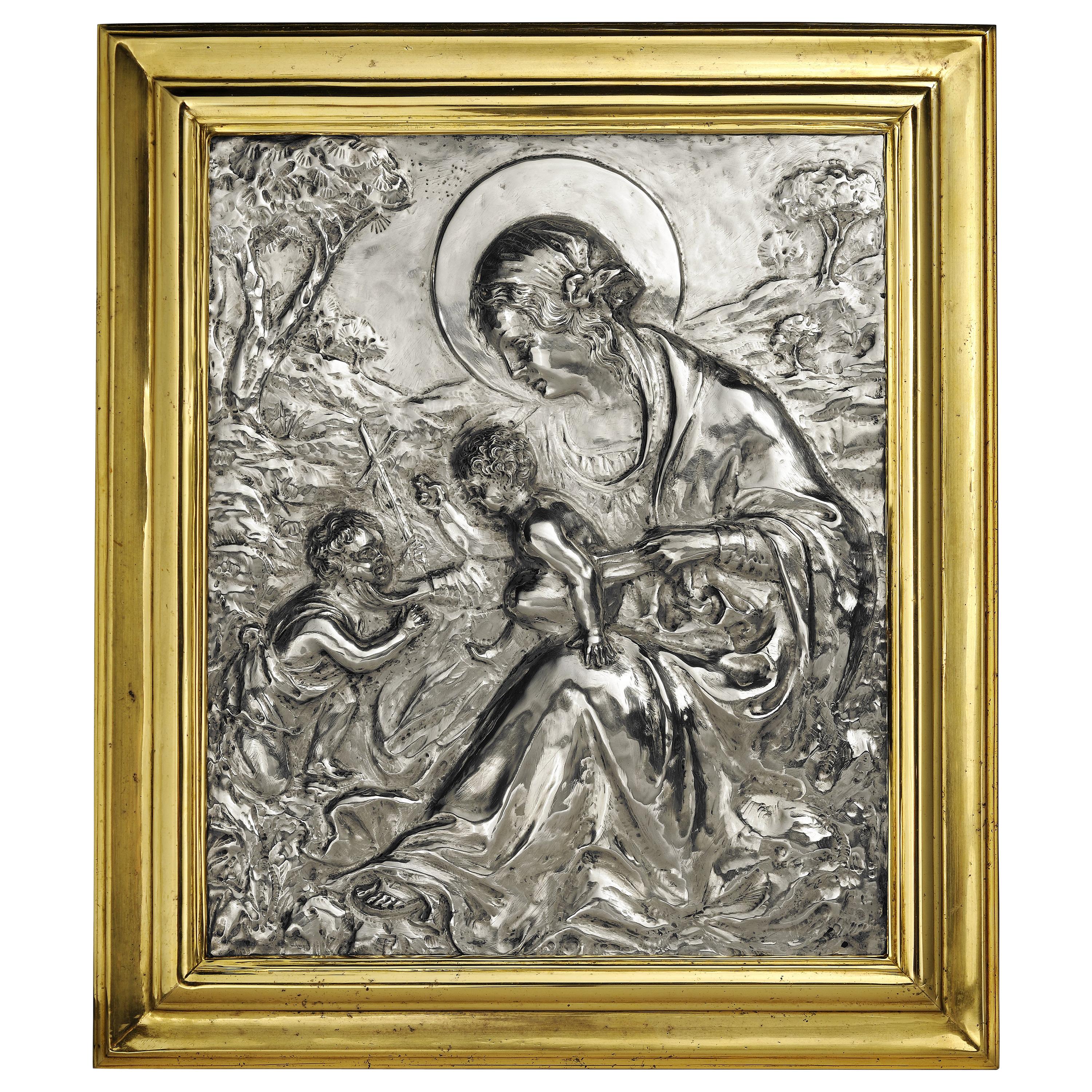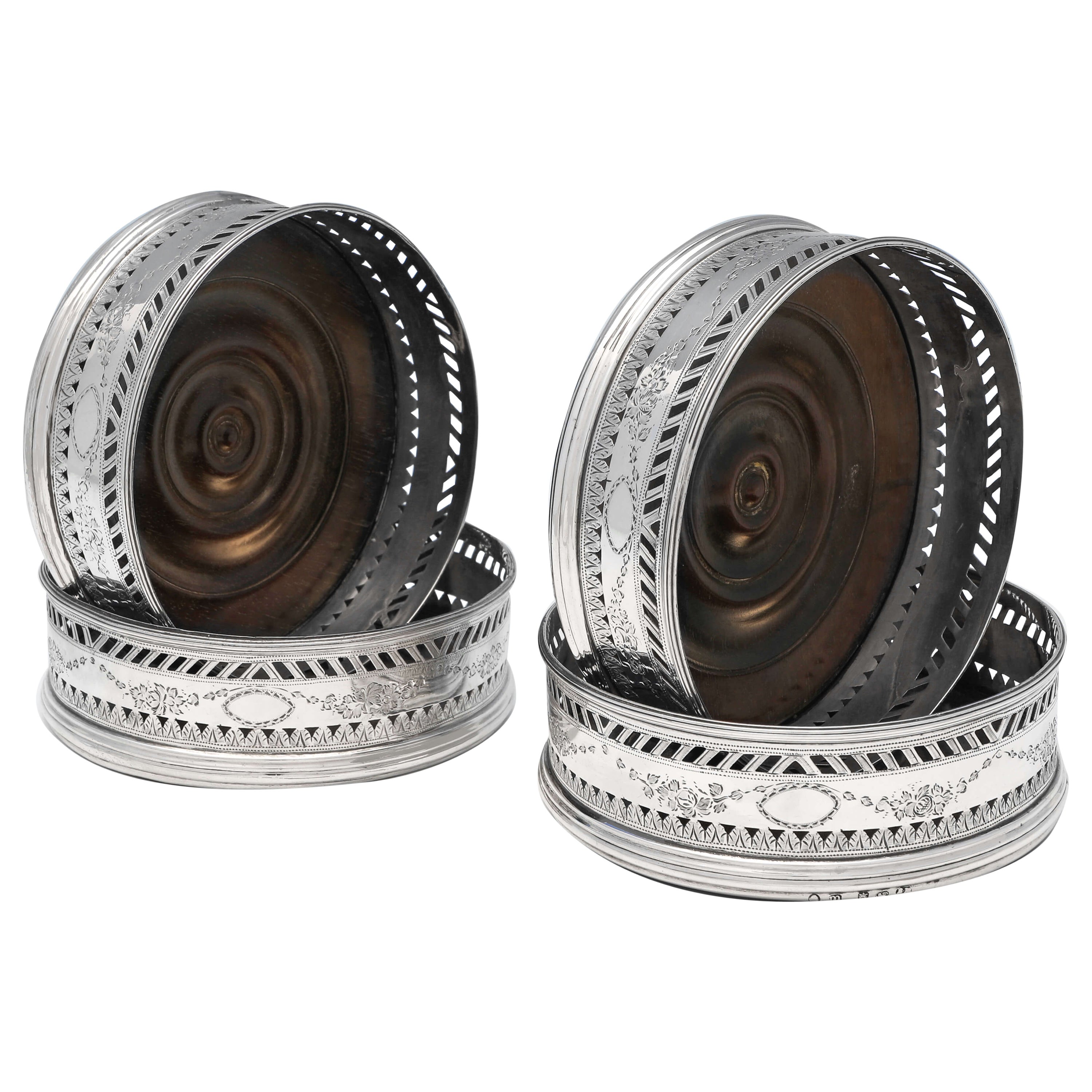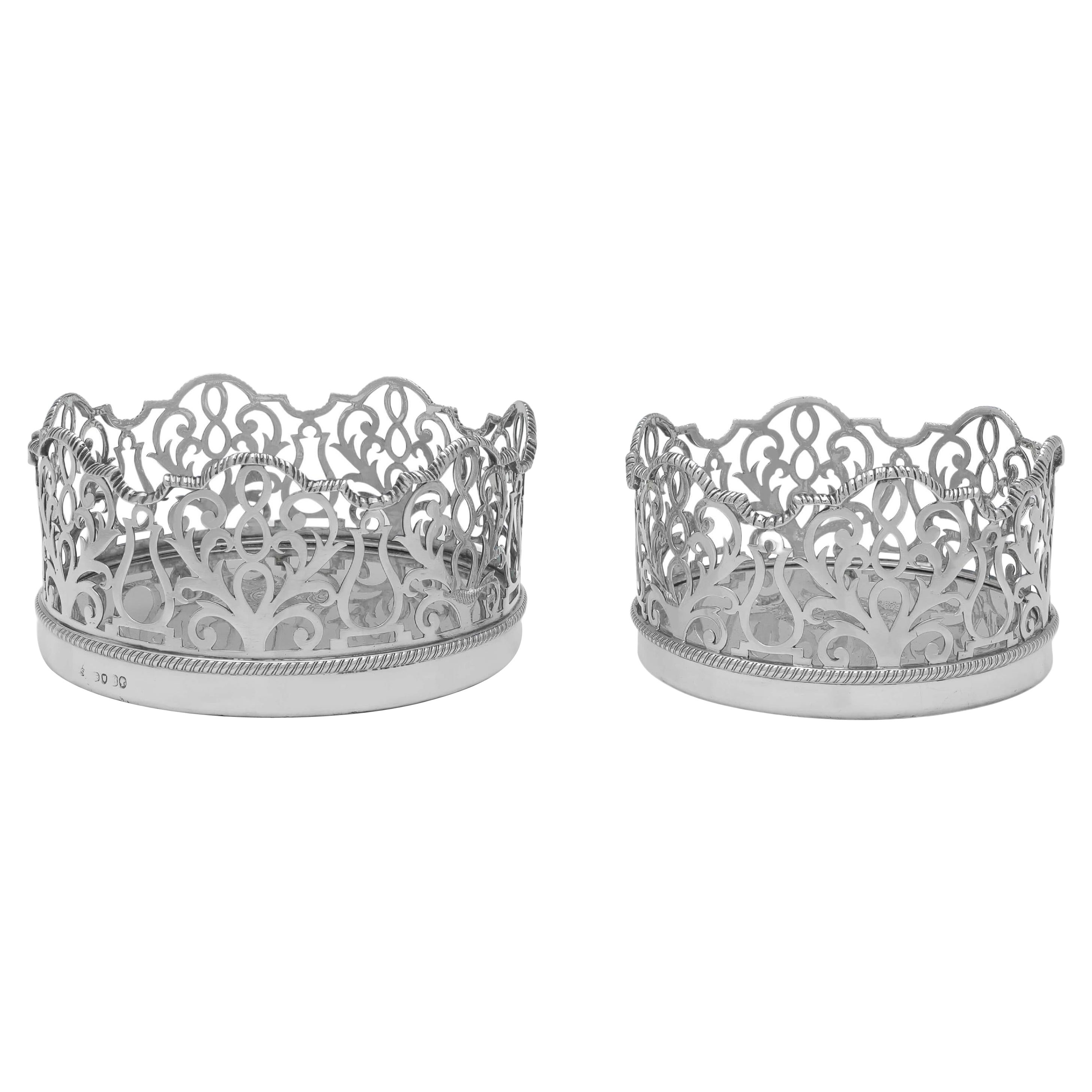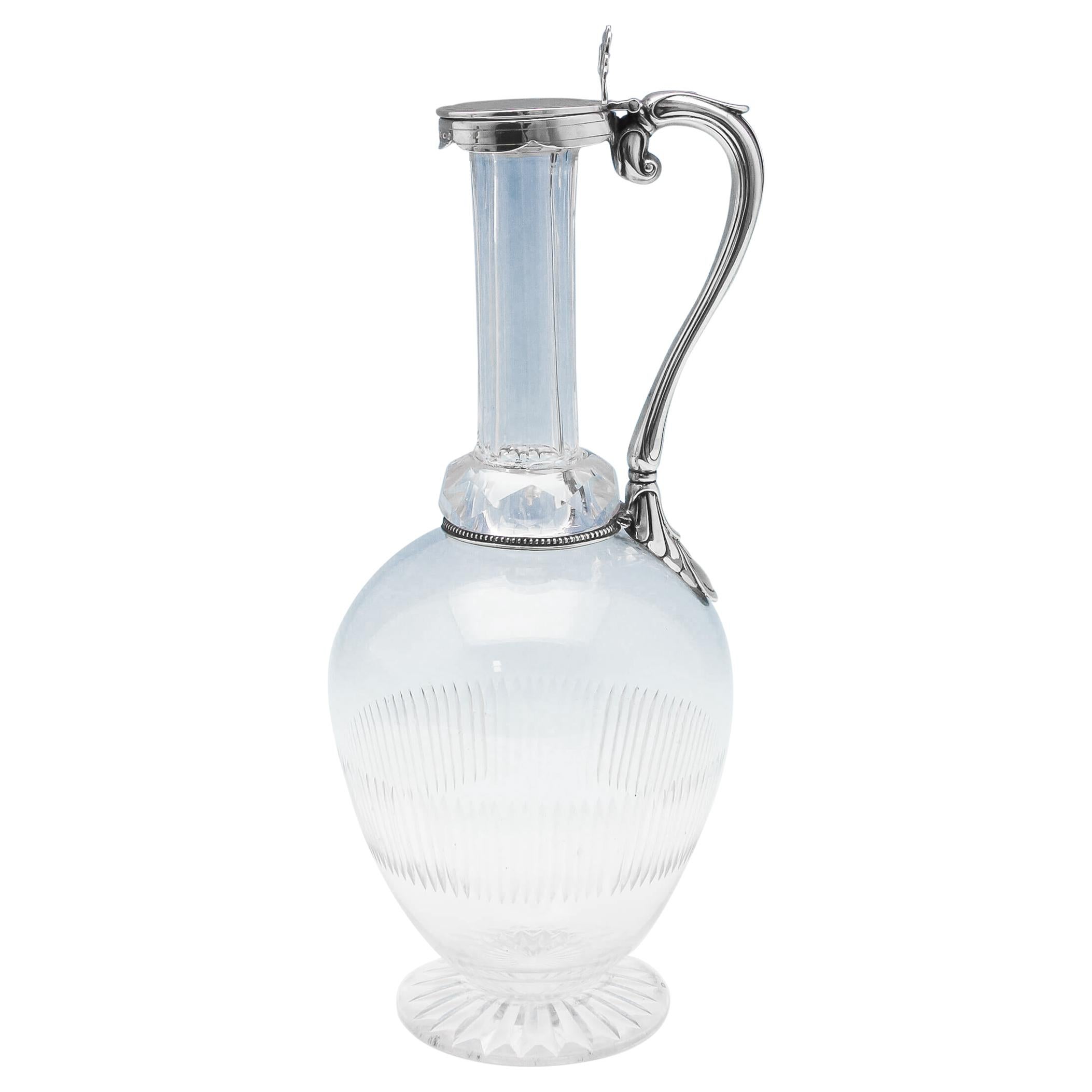Items Similar to 19th Century Italian Sterling Silver Glass and Wine Coasters, circa 1830
Video Loading
Want more images or videos?
Request additional images or videos from the seller
1 of 19
19th Century Italian Sterling Silver Glass and Wine Coasters, circa 1830
About the Item
Twelve silver glass coasters and four silver wine coasters.
Silversmith Antonio Mantelli
Milan, circa 1830
They measure:
Glass coasters: 0.78 in high x 3.46 in diameter (2 cm x 8.8 cm)
Wine coasters: 0.86 in high x 5.24 in diameter (cm 2.2 e cm 13.3)
lb 1.86 (kg 0.84)
State of conservation: slight dents and defects due to use.
Each glass coaster or wine coaster has a circular shape with a vertical brim adorned with a continuous, perforated pattern of linked palmettes. The rim is everted and decorated with lance-shaped leaves interspersed with tiny beading. At the center of the support surface is a continuous crown of leaflets in relief arranged in a V-shape.
Each of the sixteen pieces bears three marks under the base:
1)“Forma eptagona. Globo col Zodiaco ed i setti (sic) Trioni.”
Heptagon form. Globe with the Zodiac and the seven Trioni (seven stars of the Ursa Major).
Mark of the Guarantee Office in use in the Napoleonic Kingdom of Italy from 1812 for works with a title of 800 thousandths.
2) "Aratro". Plow.
Mark of the Guarantee Office in use in the Napoleonic Kingdom of Italy from 1812.
3) "Dragon" and letters "AM".
Mark of the silversmith Antonio Mantelli, active between 1830 and 1839.
Reference bibliography:
V. DONAVER - R. DABBENE, Punzoni degli argentieri milanesi dell'800, Milano, 1985;
G. SAMBONET, Gli Argenti Milanesi, Milano, 1987.
- Creator:Antonio Mantelli (Maker)
- Dimensions:Height: 0.87 in (2.2 cm)Diameter: 5.24 in (13.3 cm)
- Sold As:Set of 16
- Style:Neoclassical (Of the Period)
- Materials and Techniques:Sterling Silver,Embossed
- Place of Origin:
- Period:
- Date of Manufacture:circa 1830
- Condition:Minor fading. Slight dents and defects due to use.
- Seller Location:Milano, IT
- Reference Number:1stDibs: LU4352215395912
About the Seller
4.3
Vetted Seller
These experienced sellers undergo a comprehensive evaluation by our team of in-house experts.
Established in 1860
1stDibs seller since 2018
19 sales on 1stDibs
Typical response time: 4 hours
Associations
International Confederation of Art and Antique Dealers' Associations
- ShippingRetrieving quote...Ships From: Milano, Italy
- Return PolicyA return for this item may be initiated within 14 days of delivery.
More From This SellerView All
- 19th Century Italian Sterling Silver Madonna, circa 1830Located in Milano, ITEmbossed and engraved silver plaque La Madonna del lago (The Madonna of the Lake) Probably Milan, post 1824 Brass frame It measures 16.14 in x 13.85 in (41 x 35.2 cm) and it weighs 10.357 pounds (4.698 g): silver 1.31 pounds (598 g) + brass 9.03 pounds (4.100 g) State of conservation: some abrasions on the bottom. The frame is old, but not original. The plaque is made up of a sheet of embossed and engraved silver, and held in a solid brass frame. It depicts the “Madonna del lago” – “Madonna of the Lake” - (the Madonna with Child and San Giovannino) by Marco d'Oggiono (Oggiono, 1474 circa - Milan, 1524 circa), while changing only the background landscape. Almost certainly the subject reproduced in the plaque was taken from a famous engraving by Giuseppe Longhi (Monza, 1766 - Milan, 1831), one of the greatest engravers of his era. The silver is unmarked, probably because originally the Madonna was due to be exposed in a church: sometimes precious metals destined for worship and liturgical use would be exempted from payment and were, therefore, not marked. It is very likely that the plaque was made in Milan because in this city in 1824 the engraving by Giuseppe Longhi was made and printed. In addition, in Milan, the alleged lost painting by Leonardo da Vinci in his Milanese period (1482-1500) would be produced; this is the painting from which Marco d'Oggiono took his version. The painting Marco d?Oggiono was one of Leonardo da Vinci's most brilliant students and collaborators (D. Sedini, Marco d’Oggiono, tradizione e rinnovamento in Lombardia tra Quattrocento e Cinquecento, Roma 1989, pp. 151-153, n. 56; p. 225, n. 124, with previous bibliography). His style reflects in every way that of the Tuscan Maestro, so much so that he was the one who executed some copies of da Vinci's paintings. The execution of the “Madonna del Lago” probably draws inspiration from a lost painting by the Maestro, created while he was living in Milan (1482-1500). There are many similarities with other works by Leonardo such as the “Vergine delle rocce” or the “Vergine con il Bambino e San Giovannino, Sant’Anna e l’Agnello”. The painting, from which the drawing and then the famous engraving were taken, is found today at the M&G Museum of Bob Jones University in Greenville, South Carolina, where it came to rest after the sale of the Harrington Collection in London in 1917. The work appears in the inventories of the collection of Napoleon and Joséphine Bonaparte at the castle of Malmaison, before 1809. The Malmaison building was born and developed in the 17th and 18th centuries. In the 18th century it belonged to Jacques-Jean Le Coulteux du Molay, a wealthy banker. Later, during the Directory, Joséphine Bonaparte de Beauharnais bought it on April 21st, 1799, but settled at the castle definitively only after her husband separated from her in 1809. She remained there until 1814, the year of her death. When Joséphine died, the estate passed to her son Eugène de Beauharnais, who moved to Munich with his whole family in 1815, bringing with him the collection of paintings he inherited from his mother. Eugène died in 1824 and his wife Augusta of Bavaria (von Bayern), unable to keep it, in 1828 sold the Malmaison to the Swedish banker Jonas-Philip Hagerman. It is likely that in this period Augusta also sold part of the paintings inherited from her husband, including the “Madonna del Lago”. This painting then came into the possession of Leicester Stanhope, fifth Earl of Harrington (1784 - 1862) and then was passed down to his descendants. In 1917, at the death of Charles, eighth Earl of Harrington, his brother Dudley inherited the title and properties and he put up a part of his collections for sale. Among these, precisely, the painting by Marco d'Oggiono was to be found. On the occasion of that auction the painting was presented as a work by Cesare da Sesto, by virtue of a handwritten note by the Countess of Harrington on the back of the table. However, already in 1857, the German critic Gustav Waagen had identified Marco d'Oggiono as the author of the painting, then exhibited in the dining room of Harrington House in London (Treasures of Art in Great Britain, in 4 volumes, London, 1854 and 1857). The engraving Giuseppe Longhi was one of the most renowned engravers in Italy between the end of the 18th century and the first quarter of the 19th century. In 1824 Giuseppe Longhi, based on a design by Paolo Caronni, made a famous engraving of the painting of Marco d?Oggiono. The activity of Longhi was then at the peak of his notoriety, enough to earn him very substantial commissions; it is not risky to suppose that some of his successful engravings were also reproduced using other means: in our case in silver. (A. Crespi, a cura di, Giuseppe Longhi 1766–1831 e Raffaello Morghen...Category
Antique 1820s Italian Neoclassical Sterling Silver
MaterialsSterling Silver, Brass
- Large Italian Neoclassic Sterling Silver Coffee Pot, Milan, Circa 1830Located in Milano, ITEmbossed and engraved silver coffee pot Antonio Garavaglia Milan, Circa 1830 It measures 16.92 in (43 cm) in height and weighs 3.35 lb (1.520 gr) State of conservation: very good The large silver coffee pot has a round mouthpiece with a marked everted rim on which a pagoda lid rests; this is surmounted by a cock-shaped knob with a border decorated with small pods...Category
Antique 1820s Italian Neoclassical Sterling Silver
MaterialsSterling Silver
- Italian Silver Puerperal Cup or Small Soup Tureen, Milan Circa 1830Located in Milano, ITSilversmith L. B. Small silver soup tureen or puerperal cup with plate and lid Milan, around 1830 Height 19.5 cm (7.67 in) - diameter 21.7 cm (8.54 in) lb 2.14 (kg 0.97) State of conservation: slight use defects and a dent on the plate. From about the mid-16th century, the puerperal soup tureen or puerperal cup became one of the most popular wedding gifts in central Italy. As an auspicious symbol, it replaced the birth table...Category
Antique 1830s Italian Neoclassical Sterling Silver
MaterialsSterling Silver
- Ancient Italian Neoclassic Sterling Silver Coffee Pot, Milan, circa 1850Located in Milano, ITEmbossed and engraved sterling silver coffee pot Tommaso Panizza (1805-1868) Milan, circa half of the 19th century It measures 13.97 in (cm 35.5) in height x 8.66 in (22 cm) x 4.7...Category
Antique 1840s Italian Neoclassical Sterling Silver
MaterialsSterling Silver
- Ancient Neoclassic Sterling Silver Coffee Pot, Palermo, Sicily circa 1789Located in Milano, ITAncient Neoclassic Sterling Silver Coffee Pot, Palermo, Sicily circa 1789 Embossed and engraved silver coffee pot Silversmith, probably Agostino Natoli Diego Di Maggio, Silversmith Consul in 1789 and 1796 Palermo, 1789 It measures 14.17 in (36 cm) high and weighs 2.76 lb (1.252 g) State of conservation: few signs of use and some slight blemishes The large silver coffee pot has a round mouthpiece with a markedly everted rim, on which hinges a domed lid with very full molded pod shapes; a closed bud surmounted by a small sphere serves as a knob. The polygonal neck descends and widens into molded elements that come together, with larger pods, at the point where it is attached to the body. The body in turn is united to a well-shaped foot, which ends in a flat base with a vertical rim. From the body rises a spout with a circular mouth accented with a thick rim. An angled loop, made of ebonized wood, is applied to the neck by means of a double-cone element having a sphere at its center; it ends in a silver cone...Category
Antique 1780s Sicilian Neoclassical Sterling Silver
MaterialsSterling Silver
- 19th Century Pair of French or Russian Gilt Bronze Candelabra, circa 1830Located in Milano, ITPair of thirteen-flame candelabra France or Russia Second quarter of 19th century Cast, chiseled and gilt bronze Height 40.95 in (cm 104), diameter 17,7 in (cm 45) 97 lb (44 kg) Sta...Category
Antique 1830s French Neoclassical Candelabras
MaterialsOrmolu
You May Also Like
- Pair of Sterling Silver Wine CoastersBy Black, Starr & FrostLocated in Brooklyn, NYWe are thrilled to offer you this pair of sterling silver wine coasters by Black Starr & Frost. They have a 2.5” sterling silver rim that ...Category
Antique Early 1900s American Sterling Silver
MaterialsSterling Silver
- 19th Century English Cut Glass and Sterling Silver Oil and Vinegar Cruet SetLocated in Firenze, ITThese oil and vinegar bottles are a sleek cruet condiment set, made of fine and elaborate cut crystal and sterling silver with a neoclassical appeal thanks to the Greek key pattern t...Category
Antique Mid-19th Century English Neoclassical Sterling Silver
MaterialsCrystal, Sterling Silver
- Neoclassical Set of 4 Antique Sterling Silver Wine Coasters, London, 1787Located in London, LondonHallmarked in London in 1787, this striking set of four George III, Antique Sterling Silver Wine Coasters, feature pierced and eng...Category
Antique 1780s English Neoclassical Sterling Silver
MaterialsSterling Silver
- Rare Antique Sterling Silver Pair of Graduated Wine Coasters, Robert GarrardBy Robert Garrard II 1Located in London, LondonHallmarked in London in 1842 & 1844 by Robert Garrard II, this very rare pair of graduated Antique Sterling Silver Wine Coasters, feature pierced sides, silver bases, and engraved co...Category
Antique 1840s English Victorian Sterling Silver
MaterialsSterling Silver
- 19th Century Victorian Cut Glass & Antique Sterling Silver Claret Jug from 1870Located in London, LondonHallmarked in Birmingham, in 1870 by John Gough, this striking, Victorian, antique silver claret Jug, features cut glass, and engraved decora...Category
Antique 1870s English Victorian Sterling Silver
MaterialsSterling Silver
- 19th Century Silver and Crystal Mustard CellarBy BaccaratLocated in Casteren, Noord-BrabantBeautiful late 19th century antique mustard pot. The jar is made of colored (blue) and clear crystal and solid silver. The inside of the lid is gol...Category
Antique 1880s French Belle Époque Tableware
MaterialsCrystal, Silver
Recently Viewed
View AllMore Ways To Browse
Silver Stater
Italian Sterling
Crown Sterling
Sterling Silver Crown
800 Italy Silver
Sterling Silver Wine Glasses
Three Crowns Silver
Silver Zodiac
Silver 800 19th
Antique 800 Silver Marks
Antique Zodiac
Dragon Sterling
Dragon Sterling Silver
Milano Antique
Ceramics With Stars
Antique Wine Coaster
Sterling Coaster
Silver Wine Coaster Antique
